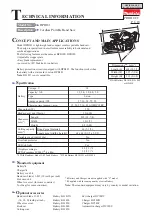
3
7.
Use the right tool.
Do not force small tools or attachments to do the
job of a heavy duty tool. Do not use tools for
purposes not intended; for example, do not use
circular saws to cut tree limbs or logs.
8.
Dress properly.
Do not wear loose clothing or jewellery, they can
be caught in moving parts. Rubber gloves and
non-skid footwear are recommended when
working outdoors. Wear protecting hair covering to
contain long hair.
9.
Use safety glasses and hearing protection.
Also use face or dust mask if the cutting operation
is dusty.
10.
Connect dust extraction equipment.
If devices are provided for the connection of dust
extraction and collection facilities ensure these are
connected and properly used.
11.
Do not abuse the cord.
Never carry the tool by the cord or yank it to
disconnect it from the socket. Keep the cord away
from heat, oil and sharp edges.
12.
Secure work.
Use clamps or a vice to hold the work. It is safer
than using your hand and it frees both hands to
operate the tool.
13.
Do not overreach.
Keep proper footing and balance at all times.
14.
Maintain tools with care.
Keep cutting tools sharp and clean for better and
safer performance. Follow instructions for
lubrication and changing accessories. Inspect tool
cord periodically and if damaged have it repaired
by an authorized service facility. Inspect extension
cords periodically and replace, if damaged. Keep
handles dry, clean and free from oil and grease.
15.
Disconnect tools.
When not in use, before servicing and when
changing accessories such as blades, bits and
cutters.
16.
Remove adjusting keys and wrenches.
Form the habit of checking to see that keys and
adjusting wrenches are removed from the tool
before turning it on.
17.
Avoid unintentional starting.
Do not carry a plugged-in tool with a finger on the
switch. Ensure switch is off when plugging in.
18.
Use outdoor extension leads.
When tool is used outdoors, use only extension
cords intended for outdoor use.
19.
Stay alert.
Watch what you are doing. Use common sense.
Do not operate tool when you are tired.
20.
Check damaged parts.
Before further use of the tool, a guard or other part
that is damaged should be carefully checked to
determine that it will operate properly and perform
its intended function. Check for alignment of
moving parts, free running of moving parts,
breakage of parts, mounting and any other
conditions that may affect its operation. A guard or
other part that is damaged should be properly
repaired or replaced by an authorized service
center unless otherwise indicated in this instruction
manual. Have defective switches replaced by an
authorized service facility. Do not use the tool if the
switch does not turn it on and off.
21.
Warning.
The use of any accessory or attachment, other
than those recommended in this instruction
manual or the catalog, may present a risk of
personal injury.
22.
Have your tool repaired by a qualified person.
This electric tool is in accordance with the relevant
safety requirements. Repairs should only be
carried out by qualified persons using original
spare parts, otherwise this may result in
considerable danger to the user.
ENB066-1
ADDITIONAL SAFETY RULES
FOR TOOL
1.
Wear protective glasses. Also wear hearing
protection during extended periods of
operation.
2.
Use only wheels recommended by the
manufacturer which have a maximum
operating speed at least as high as "No Load
RPM" marked on the tool’s nameplate. Use
only fiberglass-reinforced cut-off wheels.
3.
Check the wheel carefully for cracks or
damage before operation. Replace cracked or
damaged wheel immediately.
4.
Secure the wheel carefully.
5.
Use only flanges specified for this tool.
6.
Be careful not to damage the spindle, flanges
(especially the installing surface) or bolt, or
the wheel itself might break.
7.
Keep guards in place and in working order.
8.
Hold the handle firmly.
9.
Keep hands away from rotating parts.
10.
Make sure the wheel is not contacting the
work-piece before the switch is turned on.
11.
Before using the tool on an actual workpiece,
let it simply run for several minutes first.
Watch for flutter or excessive vibration that
might be caused by poor installation or a
poorly balanced wheel.


























